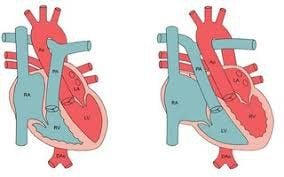This is an automatically translated article.
Hypoplastic left heart syndrome is a rare congenital disease, children born with a severe prognosis account for only about 3/10,000 children. The disease will quickly progress to death if not treated promptly. So what is hypoplastic left heart syndrome?
1. Is hypoplastic left heart syndrome dangerous?
Hypoplastic left heart syndrome is a birth defect that affects the normal blood flow through the heart. The left heart did not form properly while the baby was still developing in the womb.
Hypoplastic left heart syndrome has affected some structures on the left part of the heart and thus prevented them from fully developing, for example:
The left ventricle is too small and underdeveloped mitral valve very small or absent Aortic valve very small or absent The upper part of the aorta is too small or underdeveloped. Typically, children with hypoplastic left heart will have an atrial septal defect, which is a hole between the left and right upper chambers of the heart (the atria).
In children without congenital heart defects, the right heart pumps oxygen-poor blood to the lungs, and the left heart pumps oxygen-rich blood to the rest of the body. There are two small openings between the right and left heart chambers, the oval-valve and ductal septum, which are still in the fetal stage and close a few days after the baby is born.
In children with hypoplastic left heart syndrome, the left heart does not pump enough oxygen-rich blood to the body. Within a few days of birth, the baby's oxygen-rich blood was unable to pass through the underactive left chambers of the heart, but rather through the oval-valve and ductal stoma into the right heart. The right heart must now pump blood to both lungs and the rest of the body, and when the openings close, it becomes more difficult for oxygen-rich blood to reach the rest of the body.
2. Symptoms and signs of hypoplastic left heart syndrome
Common symptoms of hypoplastic left heart syndrome include:
Blue-gray skin color (cyanosis) Difficulty breathing, rapid breathing Poor appetite Cold hands and feet Reluctance to exercise or unusual sleepiness. In young children with hypoplastic left heart syndrome, if the natural connections between the right and left hearts (ductal ducts and valvular openings) close, the child may go into shock and may lead to death. Signs of shock are as follows:
Pale or gray skin, moist, cold pulse Fast and weak Breathing slow and shallow, breathing irregular or very fast. Dilated pupils The eyes are glazed as if they are staring. When the child is in shock, may be unconscious or still conscious, it is necessary to take the child to the hospital immediately for timely emergency care.
3. Causes of hypoplastic left heart syndrome
Most babies with heart defects such as hypoplastic left heart syndrome have no known cause. Some children have heart defects due to chromosomal or genetic changes. It may also be due to a combination of genes and other risk factors to which the mother is exposed.
During pregnancy
During pregnancy, there are screening tests that help check for birth defects and other medical conditions. Hypoplastic left heart syndrome can be diagnosed by ultrasound. There are some abnormalities from the ultrasound that can help the doctor suspect hypoplasia of the left heart. To confirm the diagnosis, the doctor may order additional tests such as an echocardiogram of the baby's heart, an electrocardiogram of the fetus.
After birth
For babies with hypoplastic left heart syndrome, the first few days after birth may not be difficult as long as the natural openings in the heart are still open. However, when these openings are closed, young children quickly develop the following signs:
Respiratory problems Rapid heartbeat Weak pulse Weak skin Blue or ash gray color.
4. Methods used to treat hypoplastic left heart syndrome
4.1. Medications Some infants and children need medication to lower blood pressure, strengthen the heart muscle, and help the body reduce excess water.
4.2. Nutrition For children with hypoplastic left heart syndrome, doctors need to prescribe high-energy nutritional products to ensure that children can gain weight and stay healthy. Because this syndrome can make children become tired while eating and lead to not eating enough to gain weight.
4.3. Surgery When a child has hypoplastic left heart syndrome soon after birth, surgery is needed to increase blood flow to other parts of the body and to bridge the underactive left heart chambers. . Surgery does not cure this syndrome, but surgery will help restore the function of the heart.
Surgery for hypoplastic left heart syndrome is usually done in three distinct stages:
Norwood maneuver: this procedure is done within the first 2 weeks of a baby's life. This surgery creates a "new" aorta for the baby and connects it to the right ventricle. Glenn Direct Double Anastomosis: This type of surgery is done when the baby is 4 to 6 months old. This surgery creates a direct connection between the blood vessel that carries oxygen-poor blood from the upper part of the body to the heart and the pulmonary artery. Fontan procedure: This surgery will be done when the child is 18 months to 3 years old. This surgery connects the pulmonary artery to the inferior vena cava, which carries oxygen-poor blood from the lower parts of the body back to the heart, allowing blood from the rest of the body to reach the lungs. The fact that babies are not cured by surgery can leave many long-term complications.
Please dial HOTLINE for more information or register for an appointment HERE. Download MyVinmec app to make appointments faster and to manage your bookings easily.













